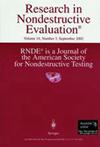Numerical Study of Rayleigh Wave Interaction with Rolling Contact Fatigue Type of Defects
IF 1.6
4区 材料科学
Q3 MATERIALS SCIENCE, CHARACTERIZATION & TESTING
引用次数: 0
Abstract
ABSTRACT Rolling Contact Fatigue or Damage (RCF/RCD) presents significant maintenance challenges to railroads across the globe. Quantifying RCF/RCD crack depths and density in rails is important for all railroads to manage their grinding programs effectively and efficiently and being able to conduct ultrasonic testing (UT) of rails for reliable detection of internal fatigue damage. This work focuses on the modeling of Rayleigh waves UT approach to detect and characterize RCF type of defects which can form as: vertical, oblique or branched shaped surface breaking defects in the rail head. Specifically, the transmission coefficient (Tc) of Rayleigh waves was studied using finite element analysis (FEA). The effect of crack tip geometry on Tc values is discussed. The results suggest that for oblique, and branch cracks, characterization based purely on the Tc can be challenging due to symmetric sinusoidal fluctuations in the Tc. A real crack using a micrograph image was also modeled to validate the Tc results for oblique and branched cracks. This points to the need for additional parameters to be identified for efficient and reliable characterization of RCF/RCD type of defects in rails.瑞利波与滚动接触疲劳型缺陷相互作用的数值研究
滚动接触疲劳或损伤(RCF/RCD)对全球铁路的维护提出了重大挑战。量化钢轨中的RCF/RCD裂纹深度和密度对于所有铁路有效和高效地管理其磨削程序以及能够对钢轨进行超声检测(UT)以可靠地检测内部疲劳损伤非常重要。这项工作的重点是瑞利波UT方法的建模,以检测和表征RCF类型的缺陷,这些缺陷可以形成:轨道头部的垂直,倾斜或分支形表面断裂缺陷。具体而言,采用有限元分析方法研究了瑞利波的透射系数。讨论了裂纹尖端几何形状对Tc值的影响。结果表明,对于斜裂纹和分支裂纹,由于Tc的对称正弦波动,纯粹基于Tc的表征可能具有挑战性。利用显微图像模拟了一个真实的裂纹,以验证斜裂纹和分支裂纹的Tc结果。这表明需要识别额外的参数,以便有效和可靠地表征轨道中RCF/RCD类型的缺陷。
本文章由计算机程序翻译,如有差异,请以英文原文为准。
求助全文
约1分钟内获得全文
求助全文
来源期刊

Research in Nondestructive Evaluation
工程技术-材料科学:表征与测试
CiteScore
2.30
自引率
0.00%
发文量
14
审稿时长
>12 weeks
期刊介绍:
Research in Nondestructive Evaluation® is the archival research journal of the American Society for Nondestructive Testing, Inc. RNDE® contains the results of original research in all areas of nondestructive evaluation (NDE). The journal covers experimental and theoretical investigations dealing with the scientific and engineering bases of NDE, its measurement and methodology, and a wide range of applications to materials and structures that relate to the entire life cycle, from manufacture to use and retirement.
Illustrative topics include advances in the underlying science of acoustic, thermal, electrical, magnetic, optical and ionizing radiation techniques and their applications to NDE problems. These problems include the nondestructive characterization of a wide variety of material properties and their degradation in service, nonintrusive sensors for monitoring manufacturing and materials processes, new techniques and combinations of techniques for detecting and characterizing hidden discontinuities and distributed damage in materials, standardization concepts and quantitative approaches for advanced NDE techniques, and long-term continuous monitoring of structures and assemblies. Of particular interest is research which elucidates how to evaluate the effects of imperfect material condition, as quantified by nondestructive measurement, on the functional performance.
 求助内容:
求助内容: 应助结果提醒方式:
应助结果提醒方式:


